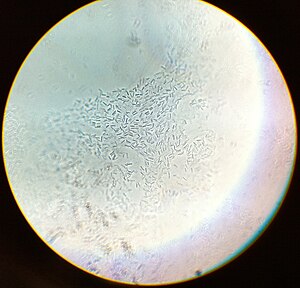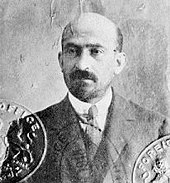क्लोस्ट्रीडियम एसिटोब्यूटाइलिकम: Difference between revisions
No edit summary |
|||
| Line 48: | Line 48: | ||
* [http://bacdive.dsmz.de/index.php?search=2529&submit=Search Type strain of ''Clostridium acetobutylicum'' at Bac''Dive'' - the Bacterial Diversity Metadatabase] | * [http://bacdive.dsmz.de/index.php?search=2529&submit=Search Type strain of ''Clostridium acetobutylicum'' at Bac''Dive'' - the Bacterial Diversity Metadatabase] | ||
[[Category:Articles with 'species' microformats]] | |||
[[Category: | |||
[[Category:Created On 28/07/2023]] | [[Category:Created On 28/07/2023]] | ||
[[Category:Machine Translated Page]] | |||
[[Category:Pages with script errors]] | |||
[[Category:Short description with empty Wikidata description]] | |||
[[Category:Template documentation pages|Short description/doc]] | |||
[[Category:Templates Vigyan Ready]] | |||
[[Category:Templates that add a tracking category]] | |||
[[Category:Templates that generate short descriptions]] | |||
[[Category:Templates using TemplateData]] | |||
Revision as of 11:10, 24 November 2023
| colspan=2 style="text-align: center; background-color: rgb(220,235,245)" | क्लोस्ट्रीडियम एसिटोब्यूटाइलिकम | |
|---|---|

| |
| colspan=2 style="min-width:15em; text-align: center; background-color: rgb(220,235,245)" | Scientific classification | |
| Domain: | Bacteria |
| Phylum: | Bacillota |
| Class: | Clostridia |
| Order: | Eubacteriales |
| Family: | Clostridiaceae |
| Genus: | Clostridium |
| Species: | C. एसिटोब्यूटाइलिकम
|
| colspan=2 style="text-align: center; background-color: rgb(220,235,245)" | Binomial name | |
| Clostridium एसिटोब्यूटाइलिकम मैककॉय एट अल. 1926 (स्वीकृत सूचियाँ 1980)
| |
क्लोस्ट्रीडियम एसिटोब्यूटाइलिकम, एटीसीसी 824, व्यावसायिक रूप से मूल्यवान जीवाणु है जिसे संभवतः यहूदी रूसी मूल के बायोकेमिस्ट चैम वीज़मैन के पश्चात् "वीज़मैन ऑर्गेनिज्म" कहा जाता है। इंग्लैंड के मैनचेस्टर विश्वविद्यालय में वरिष्ठ व्याख्याता, उन्होंने 1916 में स्टार्च से संयुक्त रूप से एसीटोन, इथेनॉल और एन-ब्यूटेनॉल का उत्पादन करने के लिए जैव-रासायनिक उपकरण के रूप में उनका उपयोग किया गया था। जो की इस विधि को एबीई प्रक्रिया, (एसीटोन बुटानॉल इथेनॉल किण्वन प्रक्रिया) के रूप में वर्णित किया गया है, जिससे एसीटोन के 3 भाग, एन-ब्यूटेनॉल के 6 और इथेनॉल के 1 भाग का उत्पादन होता है। इस प्रकार एसीटोन का उपयोग कॉर्डाइट कास्टिंग के महत्वपूर्ण युद्धकालीन कार्य में किया गया था। एल्कोहल का उपयोग वाहन ईंधन और सिंथेटिक रबर के उत्पादन के लिए किया जाता था।
यीस्ट के विपरीत, जो एल्कोहल और कार्बन डाइऑक्साइड में केवल कुछ शर्करा को पचा सकता है, जो की सी. एसिटोब्यूटाइलिकम और अन्य क्लॉस्ट्रिडिया, चीनी, स्टार्च, सेल्युलोज और संभवतः कुछ प्रकार के लिग्निन को पचा सकते हैं, जिससे एन-ब्यूटेनॉल, प्रोपियोनिक एसिड, ईथर और ग्लिसरीन निकलते हैं।
जेनेटिक इंजीनियरिंग में
2008 में, एस्चेरिचिया कोली के स्ट्रेन को ब्यूटेनॉल को संश्लेषित करने के लिए आनुवंशिक रूप से इंजीनियर किया गया था जीन क्लोस्ट्रीडियम एसिटोबुटिलिकम से प्राप्त किए गए थे।[1][2] 2013 में, शॉर्ट-चेन अल्केन्स का पहला माइक्रोबियल उत्पादन रिपोर्ट किया गया था[3] जो गैसोलीन के उत्पादन की दिशा में महत्वपूर्ण मार्ग है। जिसमे यह महत्वपूर्ण एंजाइमों में से फैटी एसाइल-सीओए रिडक्टेस, क्लोस्ट्रीडियम एसिटोब्यूटाइलिकम से आया है।
यह भी देखें
- एसीटोन-ब्यूटेनॉल-इथेनॉल किण्वन
- एसीटोन
- बुटानोल
- क्लॉस्ट्रिडियम बेजरिनकी
- इथेनॉल
संदर्भ
- ↑ M. Goho, Alexandra (2008-01-16). "बुटानॉल बनाने के लिए बेहतर बग". MIT Technology Review.
- ↑ Atsumi, S.; Hanai, T.; Liao, JC. (Jan 2008). "जैव ईंधन के रूप में शाखा-श्रृंखला उच्च अल्कोहल के संश्लेषण के लिए गैर-किण्वक मार्ग।". Nature. 451 (7174): 86–9. Bibcode:2008Natur.451...86A. doi:10.1038/nature06450. PMID 18172501. S2CID 4413113.
- ↑ Choi, YJ.; Lee, SY. (Oct 2013). "लघु-श्रृंखला अल्केन्स का माइक्रोबियल उत्पादन।". Nature. 502 (7472): 571–4. Bibcode:2013Natur.502..571C. doi:10.1038/nature12536. PMID 24077097. S2CID 4393929.
अग्रिम पठन
- Nölling J, Breton G, Omelchenko MV, et al. (August 2001). "Genome sequence and comparative analysis of the solvent-producing bacterium Clostridium acetobutylicum". J. Bacteriol. 183 (16): 4823–38. doi:10.1128/JB.183.16.4823-4838.2001. PMC 99537. PMID 11466286.
- Driessen AJ, Ubbink-Kok T, Konings WN (February 1988). "Amino acid transport by membrane vesicles of an obligate anaerobic bacterium, Clostridium acetobutylicum". J. Bacteriol. 170 (2): 817–20. doi:10.1128/jb.170.2.817-820.1988. PMC 210727. PMID 2828326.
- Zappe H, Jones WA, Jones DT, Woods DR (May 1988). "Structure of an endo-beta-1,4-glucanase gene from Clostridium acetobutylicum P262 showing homology with endoglucanase genes from Bacillus spp". Appl. Environ. Microbiol. 54 (5): 1289–92. Bibcode:1988ApEnM..54.1289Z. doi:10.1128/AEM.54.5.1289-1292.1988. PMC 202643. PMID 3389820.
- Bowles LK, Ellefson WL (November 1985). "Effects of butanol on Clostridium acetobutylicum". Appl. Environ. Microbiol. 50 (5): 1165–70. Bibcode:1985ApEnM..50.1165B. doi:10.1128/AEM.50.5.1165-1170.1985. PMC 238718. PMID 2868690.
- US 1875536
- US 1315585
- Weber, Christian; Farwick, Alexander; Benisch, Feline; Brat, Dawid; Dietz, Heiko; Subtil, Thorsten; Boles, Eckhard (10 June 2010). "Trends and challenges in the microbial production of lignocellulosic bioalcohol fuels". Applied Microbiology and Biotechnology. 87 (4): 1303–1315. doi:10.1007/s00253-010-2707-z. ISSN 0175-7598. PMID 20535464. S2CID 12601202.
- Jones, DT; Woods, DR (1986). "Acetone-butanol fermentation revisited". Microbiological Reviews. 50 (4): 484–524. doi:10.1128/MMBR.50.4.484-524.1986. PMC 373084. PMID 3540574.
- Bartha, Ronald M. Atlas & Richard (1993). Microbial ecology : fundamentals and applications (3rd ed.). Redwood City, Calif.: Benjamin/Cummings Pub. Co. p. 563. ISBN 978-0-8053-0653-8.
- Microbial Processes: Promising Technologies for Developing Countries. Washington: National Academy of Sciences. 1979. doi:10.17226/9544. ISBN 978-0-309-57050-3. Retrieved 10 May 2011.
- Wong Kromhout, Wileen (2011-03-16). "UCLA researchers engineer E. coli to produce record-setting amounts of alternative fuel". UCLA Newsroom. Archived from the original on 2015-04-18. Retrieved 2015-04-18.
बाहरी संबंध
- ATCC reference organism 824 C.Acetobutylicum. Archived 2012-03-18 at the Wayback Machine
- findarticles.com: Bacteria speeds drug to tumors - use of Clostridium acetobutylicum enzyme to activate cancer drug CB 1954.
- EPA Clostridium acetobutylicum Final Risk Assessment
- Genetic Engineering of Clostridium acetobutylicum for Enhanced Production of Hydrogen Gas: Penn State University.
- Pathema-Clostridium Resource
- Chaim Weizmann
- Type strain of Clostridium acetobutylicum at BacDive - the Bacterial Diversity Metadatabase
